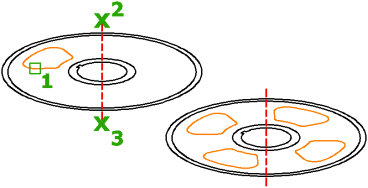Evenly distributes object copies in a circular pattern around a center point or axis of rotation.
Access Methods
Button
 Menu:
Menu:


 Command entry: Drafting tool set
Command entry: Drafting tool set  Copy tool group
Copy tool group  Array flyout
Array flyout  Polar Array
Polar ArraySummary
Creates an array by copying the selected objects around a specified center point or axis of rotation.

This command is equivalent to the Polar option in ARRAY.
After selecting objects to array and a center point for the array, the Create Array visor for polar arrays is displayed.
You can also use the Properties Inspector to set the properties of the new array while it is being created.
List of Prompts
The following prompts are displayed.
Select objects: Use an object selection method
Specify center point of array or [Base point/Axis of rotation]: Specify a center point, or enter an option
Select grip to edit array or [ASsociative/Base point/Items/Angle between/Fill angle/ROWs/Levels/ROTate items/eXit]<eXit>: Select a grip or an option
Center Point
Specifies the point around which to distribute the array items. The axis of rotation is the Z axis of the current UCS.
Base Point
Specifies a base point for the array.
- Base Point
-
Specifies a base point for positioning the objects in the array.
- Key Point
-
For associative arrays, specifies a valid constraint (or key point) on the source objects to use as the base point. If you edit the source objects of the resulting array, the base point of the array remains coincident with the key point of the source objects.
Axis of Rotation
Specifies a custom axis of rotation defined by two specified points.
Associative
Specifies whether the arrayed objects are associative or independent.
- Yes. Contains array items in a single array object, similar to a block. With an associative array, you can quickly propagate changes throughout the array by editing the properties and source objects.
- No. Creates array items as independent objects. Changes to one item do not affect the other items.
Items
Specifies the number of items in the array using a value or expression.
Angle Between
Specifies the angle between items using a value or expression.
Fill Angle
Specifies the angle between the first and last item in the array using a value or expression.
Rows
Specifies the number of rows in the array, the distance between them, and the incremental elevation between row.
- Number of Rows
-
Sets the number of rows.
- Distance Between Rows
-
Specifies the distance between each row, measured from equivalent locations on each object.
- Total
-
Specifies the total distance between the start and end row, measured from equivalent locations on the start and end objects.
- Incrementing Elevation
-
Sets the increasing or decreasing elevation for each subsequent row.
- Expression
-
Derives the value based on a mathematical formula or equation.
Levels
Specifies the number and spacing of levels (for 3D arrays).
- Number of Levels
-
Specifies the number of levels in the array.
- Distance Between Levels
-
Specifies the distance between the levels.
- Expression
-
Derives a value using a mathematical formula or equation.
- Total
-
Specifies the total distance between the first and last levels.
Rotate Items
Controls whether items are rotated as they are arrayed.
Exit
Exits the command.